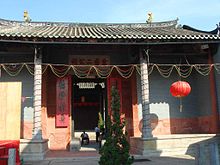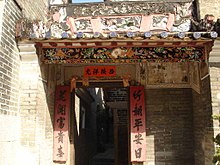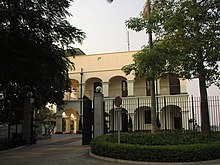Ping Shan Heritage Trail
The Ping Shan Heritage Trail ( Chinese 屏山 文物 徑 ) is an educational trail in the Ping Shan area of the Yuen Long District in Hong Kong . The trail opened on December 12, 1993, making it the first of its kind in Hong Kong. Over a length of about 1.6 kilometers, the path runs through the villages of Hang Tau Tsuen, Hang Mei Tsuen and Sheung Cheung Wai along various architectural monuments and other historical and protected buildings. A visitor center and gallery opened in 2007 at the former Ping Shan Police Station.
Attractions
The path includes the following 12 historical buildings:
Tsui Sing Lau Pagoda
The Tsui Sing Lau Pagoda ( 聚星 樓 ) is Hong Kong's only ancient pagoda ; it has been protected as a declared monument since December 2001 . The structure, whose name can be translated as the pagoda of the gathered stars , was built more than 600 years ago. Probably Tang Yin-tung was the builder. According to oral tradition, the hexagonal shaped pagoda originally had seven floors, four of which were destroyed by violent weather events. Today the tower still has three floors and is about 19 meters high.
The pagoda was also built to enhance the Feng Shui of the area; in particular, flood disasters should be prevented. Align with Castle Peak Mountain and ensure social success for the Tang clan. There is a statue of Fui Shing on the top floor .
Sheung Cheung Wai
Sheung Cheung Wai ( 上 璋 圍 ) is a walled village , i.e. a village that is still surrounded by a wall.
Yeung Hau Temple
The Yeung Hau Temple is one of six temples in Yuen Long , the Hau Wong of, a General Song Dynasty are dedicated. The exact construction time of the temple is not known, the last renovations took place in 1991 and 2002.
Historical fountain
This fountain is estimated to be 200 years old and was probably built before Sheung Cheung Wai was built. Here too, however, the building cannot be precisely dated. The well served as the main source of water for the villages of Sheung Cheung Wai and Hang Tau Tsuen.
Shrine of the earth god
West of Sheung Cheung Wai is a shrine dedicated to the earth deity She Kung , who is considered the protector of the villagers. Alternative names for the deity are Pak Kung , To Tei Kung and Fuk Tak Kung .
Tang ancestral hall
The Tang Ancestral Hall is one of the largest ancestral halls in Hong Kong and is located between Hang Mei Tsuen and Hang Tau Tsuen. It was built about 700 years ago by an ancestor of the local Tang clan, Tang Fung-shun, and forms the main ancestral hall of the Tang family. The building complex consists of three halls and two inner courtyards. The wooden girders and beams of the halls are decorated with symbols of luck. The hall was renovated from 1990 to 1991 and has been a listed building since 2001. The building is still used for ceremonial purposes and devotions.
Yu-Kiu ancestral hall
The Yu-Kiu Ancestral Hall is located south near the Tang Hall. Both halls have the same architecture, so this building also comprises three halls with two inner courtyards. It was built in the early 16th century by two 11th generation brothers of the Tang clan, Tang Sai-yin and Tang Sai-chiu. In addition to serving as an ancestral hall, the buildings were used as a primary school from 1931 to 1961.
Kun Ting Study Hall
The Kun Ting Study Hall was built in 1870 for candidates to prepare for the Chinese exam . When the New Territories came under British control in 1899, the two parts of the hall served as a police station.
Ching Shu Hin
Ching Shu Hin is a two-story L-shaped building and is adjacent to the Kun Ting Study Hall, to which it is connected by a small bridge. It was built as a guest house for famous researchers and scholars shortly after the Study Hall.
Hung Shing Temple
The Hung Shing Temple was also built by the Tang family, probably in 1767 during the reign of Emperor Qianlong . The existing structure was rebuilt in 1866, followed by extensive renovation in 1963.
Shut Hing Study Hall entrance hall
The Shut Hing Study Hall was built in 1874 to commemorate Tang Shut-hung. The back was torn off in 1977.
Ping Shan Tang Clan Gallery and Visitor Center
The Ping Shan Tang Clan Gallery opened with the Heritage Trail Visitor Center in 2007. It is located in the former Ping Shan Police Station, which is the only colonial building along the nature trail. It was built in 1900 and is one of the few surviving pre-war police buildings in the New Territories .
Web links
Individual evidence
- ^ Ping Shan Heritage Trail. Antiquities and Monuments Office, November 13, 2015, accessed November 28, 2017 .
- ^ Ping Shan Tang Clan Gallery cum Heritage Trail Visitors Center. Antiquities and Monuments Office, May 12, 2016, accessed November 28, 2017 .
- ↑ Yeung Hau Temple. Antiquities and Monuments Office, May 12, 2016, accessed November 29, 2017 .
- ↑ Old Well. Antiquities and Monuments Office, May 12, 2016, accessed November 29, 2017 .
- ^ Shrine of the Earth God. Antiquities and Monuments Office, May 12, 2016, accessed November 29, 2017 .
- ↑ Ping Shan Heritage Trail: Tang Ancestral Hall. Education and Manpower Bureau, May 12, 2016, accessed November 29, 2017 .
- ^ Tang Ancestral Hall. Antiquities and Monuments Office, May 12, 2016, accessed November 30, 2017 .
- ↑ Yu Kiu Ancestral Hall. Antiquities and Monuments Office, May 12, 2016, accessed November 30, 2017 .
- ↑ Ching Shu Hin. Antiquities and Monuments Office, May 12, 2016, accessed November 30, 2017 .
- ↑ 1,444 Historic Buildings and New Items in addition to 1,444 Historic Buildings. (pdf) Antiquities Advisory Board, September 11, 2017, accessed November 30, 2017 .
- ^ Ping Shan Tang Clan Gallery cum Heritage Trail Visitors Center. Antiquities and Monuments Office, May 12, 2016, accessed November 30, 2017 .
Coordinates: 22 ° 26 ′ 41.6 ″ N , 114 ° 0 ′ 26.3 ″ E









